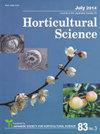Yield and Dry Matter Production of a Japanese Tomato ‘Momotaro York’ Are Improved by Grafting onto a Dutch Rootstock ‘Maxifort’
Journal of The Japanese Society for Horticultural Science
Pub Date : 2014-05-09
DOI:10.2503/JJSHS1.CH-048
引用次数: 16
Abstract
To improve the yield of a Japanese tomato (Solanum lycopersicum) cultivar and determine how fruit yield changes as a result of grafting, we investigated the effects of a Dutch rootstock [‘Maxifort’ (S. lycopersicum × S. habrochaites): Mx] on the dry matter (DM) production and fruit yield of Dutch and Japanese cultivars. The Japanese cultivar (‘Momotaro York’: My) grafted onto Mx (My/Mx: scion/rootstock) had significantly higher fresh and dry weights of fruits per unit area than My/My. Fruit fresh weight yield per unit area was highly correlated with fruit dry weight (DW) yield (r = 0.96–0.97, P < 0.001), and DW yield was significantly correlated with total aboveground DM (r = 0.71–0.96, P < 0.001) and with DM allocation to the fruits (r = 0.52–0.75, P < 0.01). Total aboveground DM (TDM) was significantly and highly correlated with light-use efficiency (r = 0.98, P < 0.001). However, there was no significant correlation between light-use efficiency and the maximum photosynthetic rate, stomatal conductance, or the light-extinction coefficient. Although stomatal conductance significantly (P < 0.05) differed between the rootstocks at 57 and 119 days after transplanting (DAT), there was no significant difference in the maximum photosynthetic rate between the scion/rootstock combinations at 57 and 119 DAT. These results indicated that the fruit yield of My could be improved by grafting onto Mx, and that the increases in yield and TDM were mainly determined by the increase in light-use efficiency.嫁接荷兰砧木‘Maxifort’提高日本番茄‘Momotaro York’的产量和干物质产量
为了提高一个日本番茄(Solanum lycopersicum)品种的产量并确定嫁接后果实产量的变化,我们研究了荷兰砧木[' Maxifort ' (S. lycopersicum × S. habrochaites): Mx]对荷兰和日本品种干物质(DM)产量和果实产量的影响。嫁接到Mx(接穗/砧木)上的日本品种‘Momotaro York’:My的单位面积果实鲜重和干重均显著高于My/My。果实单位面积鲜重产量与干重(DW)产量高度相关(r = 0.96 ~ 0.97, P < 0.001),干重产量与地上总干重(r = 0.71 ~ 0.96, P < 0.001)、干重分配与果实干重分配极显著相关(r = 0.52 ~ 0.75, P < 0.01)。地上总DM (TDM)与光能利用效率呈极显著高度相关(r = 0.98, P < 0.001)。而光能利用效率与最大光合速率、气孔导度、消光系数均无显著相关。移栽后57天和119天砧木间气孔导度差异显著(P < 0.05),但57天和119天接穗/砧木组合间最大光合速率差异不显著。这些结果表明,嫁接到Mx上可以提高My的果实产量,产量和TDM的增加主要是由光能利用效率的提高决定的。
本文章由计算机程序翻译,如有差异,请以英文原文为准。
求助全文
约1分钟内获得全文
求助全文
来源期刊
自引率
0.00%
发文量
0
审稿时长
>36 weeks

 求助内容:
求助内容: 应助结果提醒方式:
应助结果提醒方式:


